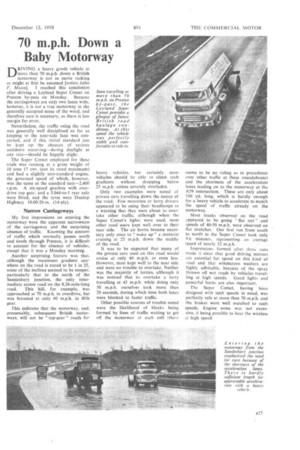70 m.p.h. Down a Baby Motorway
Page 61

If you've noticed an error in this article please click here to report it so we can fix it.
DRIVING a heavy goods vehicle at more than 70 m.p.h. down a British motorway is not as nerve racking as might at first be assumed [writes John F. Moon]. I reached this conclusion after driving a Leyland Super Comet on Preston by-pass on Monday. Because the carriageways are only two lanes wide, however, it is not a true motorway in the generally accepted sense of the word, and therefore care is necessary, as there is less margin for error.
Nevertheless, the traffic using the road was generally well disciplined so far as keeping to the near-side lane was concerned, and if this initial standard can be kept up the chances of serious accidents occurring—during daylight at any rate—should be happily slight.
The Super Comet employed for these trials was running at a gross weight of 10 tons 17 cwt. (not its rated maximum) and had a slightly non-standard engine, the governed speed of which, however, was the same as the standard unit-2,400 r.p.m. A six-speed gearbox with overdrive top gear, and a 5.044-to-1 rear axle were fitted, and the tyres were Dunlop Highway 10.00-20-in. (14-ply).
Narrow Carriageways
• My first impressions on entering the motorway were the apparent narrowness of the carriageway and the surprising absence of traffic. Knowing the amount of traffic which normally . passes north and South through Preston, it is difficult to account for the absence of vehicles, except that it was a Monday morning.
Another surprising feature was that. although the maximum gradient anywhere on the road is slated to be 1 in 25, some of the inclines seemed to be steeper, particularly that to the north of the Samlesbury junction, the only intermediate access road on the 8.26-mile-1ong road. This hill, for example, 'Was approached at 70 m.p.h. in overdrive, but was breasted at only 40 m.p.h. in fifth gear.
This indicates that the motorway, and, presumably, subsequent British motorways, will not be " top-gear" roads for heavy vehicles, but certainly most vehicles should be able to climb such gradients without dropping below 25 m.p.h. unless severely overladen, Only two examples were noted of private ears travelling down the centre of the road, Few motorists or lorry drivers appeared to be using their headlamps as a warning that they were about to overtake other traffic, although when the Super Comet's lights• were used, most other road users kept well over to their near side. The air horns became necessary only once to wake up" a motorist er'uising at 25 m.p.h. down the middle of the road.
It was to be expected that many of the private cars used on this road would cruise at only 40 m.p.h. or even less. However, most kept well to the near side and were no trouble to overtake. Neither was the majority Of lorries, although it was noticed that to overtake a lorry travelling at 45 m.p.h. while doing only 50 m.p.h. ourselves took more than 20 seconds, during which time both lanes were blocked to faster traffic. • Other possible sources of trouble noted were the likelihood of blocks being formed by lines of traffic waiting to get off the motorway at each etk'd (there seems to be no ruling as to preCedence over other traffic at these roundabouts) and the shortness of the acceleration lanes leading on to the motorway at the A59 intersection. These are only about 100 yd. long, which is hardly enough for a heavy vehicle to accelerate to match the speed of traffic already on the motorway. .
Mosttrucks observed on the road appeared' to be going "flat Out" and speeds of 40-50 m.p.h. were observed on flat stretches. Our first run from south to north in the Super Comet took only 9.6 minutes, representing an .average speed of nearly 52 m.p.h.
Impressions formed after these runs made it clear that good driving 'mirrors are essential for speed on this 'kind of road and that windscreen washers are highly advisable, because of the spray thrown off wet roads by vehicles travelling at high speeds. Good lights and powerful horns are also important.
The Super Comet, having been designed with such speeds in mind, was perfectly safe at more than 70 m.p.h. and the brakes were well matched to such speeds. Engine noise was not excessive, it being possible to hear the wireless at high speed.




















































































































